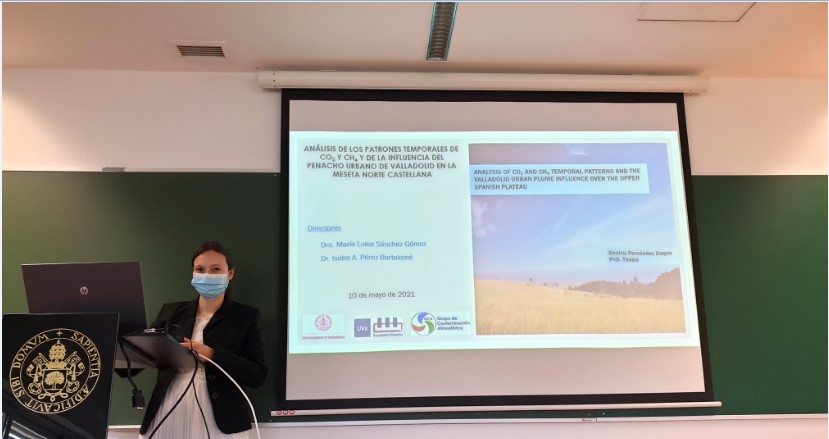Analysis of CO2 and CH4 temporal patterns and the Valladolid urban plume influence over the upper Spanish plateau
| Doctorate in Physics |
| Doctor: Beatriz Fernández Duque |
| Date of reading: 10/05/2021 |
| Directors: María Luisa Sánchez Gómez y Isidro Alberto Pérez Bartolomé |
| Court: |
Introduction
 Since the Industrial Revolution, the atmospheric mixing ratios of greenhouse gases (GHG) have changed due to human activities, leading to an increase in the average temperature of the planet. Determining GHG at regional background sites is crucial vis-à-vis assessing what impact anthropogenic emissions have on the atmospheric environment. However, observational studies are still scarce at such background sites.
Since the Industrial Revolution, the atmospheric mixing ratios of greenhouse gases (GHG) have changed due to human activities, leading to an increase in the average temperature of the planet. Determining GHG at regional background sites is crucial vis-à-vis assessing what impact anthropogenic emissions have on the atmospheric environment. However, observational studies are still scarce at such background sites.
Objectives
The current thesis first seeks to improve existing knowledge concerning the evolution of the two major GHG (CO2 and CH4) in terms of trends, growth rate and seasonal variations in the lower atmosphere. Secondly, the impact of the Valladolid urban plume on the final CO2 and CH4 mixing ratios recorded at the Low Atmosphere Research Centre (CIBA) was analysed. To achieve these goals, dry continuous CO2 and CH4 mixing ratios were obtained over five and a half years using a Picarro G1301 analyser at the CIBA station on the upper Spanish plateau. This is the first study conducted at CIBA with such lengthy records, employing a database collected with a high precision instrument and differentiating between diurnal and nocturnal records.
Development
Firstly, the time series was detrended and deseasonalised from the observed values by employing different mathematical functions so as to capture the intrinsic dynamics of the time series associated to different phenomena. The use of different functions enabled detection of possible bias caused by the method applied and provided a comparison among the functions in terms of ease of use, computational cost and data fit.
The first manuscript used a harmonic equation comprising a third-degree polynomial (trend) plus a series of four harmonics (seasonal cycle), each made up of a constant and a variable part along the time series.
The second manuscript applied an Epanechnikov, a Gaussian, a biweight, a triangular, a tricubic and a rectangular kernel function to extract the salient features of the temporal patterns. Moreover, a novel method for simultaneously determining the optimal bandwidths of kernel functions for the long and short-term based on experimental contour plots was proposed.
The third manuscript was grounded on the hypothesis that local linear regressions were able to capture CO2 and CH4 temporal evolution equally as well as quadratic linear regressions.
The results derived from the temporal analysis pointed to different behaviour between day and night CO2 and CH4 measurements, with the highest mixing ratios during the night-time when atmospheric mixing and turbulent processes are low. A seasonal pattern was also inferred for both gases, revealing summer minima, partially due to greater summertime photosynthesis as regards CO2 and to maximum OH concentration during the summer as regards CH4. As regards nocturnal CO2 data, two maxima, one in spring and another in autumn, were reported.
These two maxima were linked to an increase in rainfall which corresponded to a period of maximum vegetation growth, thus increasing respiration rates. For CO2 daytime records, only the spring peak was detected. A simpler cycle was found for CH4, showing only a maximum for diurnal and nocturnal data in winter, partially due to the low presence of OH radicals. Increasing growth rates were obtained for both gases with slight differences among values at other sites partially attributable to the impacts of anthropogenic emissions near the background sites and to regional atmospheric transport.
Secondly, it should be considered that assessing the link between atmospheric mixing ratios and wind direction data help to identify possible pollution sources, thereby giving additional information to the previous temporal patterns described. Unfortunately, the influence of urban plumes on the final measurements recorded at rural stations has rarely been touched upon in detail.
Thus, in order to provide a full understanding of the temporal patterns at CIBA, a fourth manuscript considering CO2 and CH4 mixing ratios, surface wind direction data and back-trajectories at 500 m a.g.l. computed with the METEX model, was produced to analyse the impact of the Valladolid urban plume on the final mixing ratio measured at the station.
Conclusions
The final south-westerly component of the urban mean back-trajectory, its longer time spent travelling over the Iberian Peninsula and its recirculation in the final 24 h before impacting the CIBA, might result in more pollutants being dragged to the station. As a result, the highest CO2 and CH4values were detected for southern sectors, showing what effect the Valladolid plume has on final CO2 and CH4 measurements. Finally, the results derived from the current thesis prove crucial in terms of understanding the processes that govern CO2 and CH4 trend and cycle evolution. Describing the gases in this way would enable more effective mitigation policies to be planned in order to achieve the goal of reducing the amount of greenhouse gases in the atmosphere.